Archive of ‘First Year Seminar: Visual Studies’ category
Faculty Presentations
Tammie Rubin
Tammie’s work is very interesting. As a graphic designer, I hadn’t given much thought to 3-D work. However, after seeing Tammie’s interpretation of ceramics as sculptural, rather than functional, I am very intrigued. The idea of a chimera, something that it hoped or wished for but is actually illusionary, is really thought provoking. Her work reminds me of surrealism, but takes on a new life because of the medium. I am also very interested in how the places that Tammie has lived affect her artwork. I had never thought of interaction with nature as controlled or uncontrolled, but it makes perfect sense when you see her work and think about it in relation to Chicago and Seattle.
Kim Garza
Kim worked as a designer for fourteen years before she became a professor. It really shows in the way she showed us her work on an app. It felt like she was pitching the idea to clients, which she has. In contrast, her passion project “Till the Clouds Roll By” was a completely different animal. Her work with her husband on this film felt more like fine art than any digital rendering I’ve seen before. I was starting to worry that the digital medium was simply meant for communication arts alone, but Kim has proved that digital can be just as beautiful as any traditional medium.
James Shurin
I was really interested that James’ topic has stayed pretty much consistent throughout his work. It makes sense, considering it’s such a broad and engaging idea. Things that happen “by accident” or without aesthetic intention are often the most beautiful. The challenge comes in being able to record that accident or recreate it artistically without making it seem staged.
Course Reflection
I’ve really enjoyed my first semester in the visual studies program at St. Edward’s. I think that this class is a good way to frame the program for students just entering the program. I definitely have benefitted from spending time with art and photo comm students who I’m not sure I would have met otherwise. It’s also really cool to be taught by the professors who we’ll be learning from later in our St. Ed’s careers – a way to see where we are headed. There wasn’t a lot of structure to the course, but I enjoyed that. We were able to let the conversation guide what we learned and that was very insightful.
Faculty Presentations
Tuan Phan
Tuan makes a lot of things for other people. I’ve heard the term “passion projects” a lot and it seems like all of these design gifts that he makes are a way to keep his design brain going while still doing his job – teaching us. It’s really cool to see the kind of work that he makes, especially because I know that he has a really good understanding of the principles he’s teaching. I feel like designers usually get further away from the basics as they progress in their career, but Tuan is reminded of them every day when he teaches them to us.
Hollis Hammonds
Hollis’s interpretation of memory is really interesting. I loved getting to know her better by seeing her incredibly personal work. I feel like she shows so much more through her art than the small teases she has let out through the semester. Hollis plays a game with her students where she says completely outrages things about her self and then moves on like she didn’t say anything. I feel like I’ve been trying to piece together Hollis and decipher what she means when she divulges small bits of information about her personal life. It’s very interesting to see the artwork of my professor because it gives me a clearer idea of who she is as a person.
Bill Kennedy
Bill made it big in his field and had to look further to find something fulfilling. He was successful and still is, but now – after a lot of searching – he’s found something that he enjoys doing. I really love Bill’s images of the Southwest. I grew up visiting my grandmother in Santa Fe three or four times a year and even though his images are manipulated to the extreme, I could still feel the area in his work. It was really cool to see his work evolve into something that really makes him happy.
Five Year Plan

On a Saturday morning, I attended a portfolio workshop at St. Edward’s put on by the AIGA. I was easily the youngest one there by almost three years. I realized that the focus of the workshop was on students getting ready to enter the field of design, exactly where I will be in a few years. I learned so much, but a few things really stuck out…
- keep a record of your work
- consider PROCESS when showing your work
- learn how to communicate verbally
- find a mentor
- IDEAS > AESTHETICS
-

-
2015. Helaine A. Bach. DATE NIGHT TICKET, Digital Rendering 1536 x 2500 pi
-

-
2015. Helaine A. Bach. FIRE, Paint on Wood 4 x 8 ft
-

-
2015. Helaine A. Bach. MOUNT SINAI, Graphite Sketch 7 x 5 in
Alumni Presentations
Lynne Bowman Cravens
Lynne talked about how when you start making art, it’s good to create about the subjects that you are familiar with. I’m really interested in Lynne’s combination of photography with alternative processes. Her work is unique from a lot of the things I’ve seen before, and it made me think a lot about the different methods I could use to make art. I loved how in depth she went into her processes, especially because I feel like I could now experiment and recreate something similar myself.
Miranda Petrosky
Miranda talked a lot about the process of working in a design field. This made me think a lot about the practical applications of a graphic design degree. Miranda was really helpful because she gave us a lot of examples of places in Austin that do design work. I hadn’t ever seen a lot of the places she mentioned and now I want to look into them for possible internships and career options. She also emphasized the importance of doing work for fun, and always exercising your design muscles.
Dustin Meyer
To be completely honest, I thought Dustin Meyer was full of himself and kind of annoying, but I think that’s an important skill to hone in order to make it in the world of wedding photography.
Design Internships
This second round of alumni presentations opened my eyes to the possibilities for work in Austin. I came to St. Edward’s largely because of the amazing creative scene, but I managed to forget about that in all the excitement of my first semester here. I am so ready to take full advantage of all that Austin has to offer, including the amazing opportunities for internships…
GDS&M: https://www.gsdm.apply2jobs.com/ProfExt/index.cfm?fuseaction=mExternal.showSearchInterface
Bakery: http://www.bakery.agency/careers/design-intern/
Electronic Arts: https://www.velvetjobs.com/gd/featuredjob/media/guest/297546
A Friday evening following a very long week… I don’t think any one would have blamed me if I had passed on an artist talk, especially right before the campus Halloween block party. However, I am so glad that I went. Hearing an artist talk about their work before viewing it changes the experience exponentially. Rather than guessing at what may have inspired a piece, you get to hear first hand at least a glimpse into the process behind the art. Even more so, I was so grateful for the experience to enter a dialogue with the art by asking questions. We talk about conversation with art and it seems so abstract, but when you are sitting in an auditorium literally speaking to the artist and hearing what they have to say in response, it provides a completely new perspective.
Martin Nguyen’s story was incredibly inspiring. I loved the way he spoke about the images that stay in his mind throughout his life. He showed us his last view of Vietnam as he left on a fishing boat and I was transported with him, imagining what it must be like to have that image burned in my mind. His explanation of using his art as a religious practice was also really moving. I’ve explored my own faith through art and it’s interesting to hear someone else’s perspective on this. It was incredible to hear Nguyen’s description of his process for painting a face. He devotes himself entirely to subject for two or three hours, doing his best to truly take time to see them. This was the thought that stuck in my mind as I moved to the gallery to see Nguyen’s work.
I had peered in through the windows of the art building throughout the week and caught glimpses of the work, but seeing it all as it was meant to be shown for the first time, after having just listened to the artist speak, was a whole different experience. I tried my best to both take in the piece as a whole and appreciate every subject. I have a feeling I’ll be spending more time in the gallery in the days to come. I want to get to know at least some of these faces the way that Nguyen did by painting them.

Description
Looking at time through the lens of art allows both the artist and the viewer to slow time down and appreciate the beauty of the subject for what it really is. Martin Nguyen’s collection “Drawing/Painting TIME” shown in the Fine Arts Gallery from October 23 to November 12, 2015 uses both drawing and painting to depict the portraits of people caught in time. The artwork appears to be a grid of faces, each taking up about the size of a sand dollar, on large canvases. Some of the faces are painted in black and white and others in color. There is a year below each subject, but no other identifying information. There are pencil marks present on the finished piece, showing where measurements were made to grid the faces.
Analysis
The presentation of of the subjects is what struck me as most powerful. I don’t think the individual faces Nguyen painted would be as interesting if they were not all together in such a calculated manner. At the same time, the grid like appearance would be boring if it weren’t on such a large scale. I think the balance that Nguyen was able to find is very effective. The variety of the different faces is also really engaging. It’s possible to see Nguyen’s work many times and notice a new face each time.
Interpretation
The artist is trying to capture a moment in time of the lives of different people with his interpretations of their faces. Each painting or drawing he does is a representation of a whole person and the image the viewer sees is only a glimpse of that. It’s almost like a game trying to figure out the life behind each of the faces. This creates an interactive experience for the viewer.
Evaluation
At first glance, I appreciated the artwork for the way all of the components worked together. As I thought about it more, I was more impressed by the concept of evaluating each face, each component of the piece and how they all are individual and also contribute to the whole. The use of time stamps below the faces adds another level to the work. It’s interesting to think that the only reason all of these images exist in the same space together is because the artist put them there. Nguyen’s work makes me want to do more portraits. I want to be able to see a person and their whole life in a single image and then share that life with my viewers.
Initial notes from presentations…

Nick Swift
I was really inspired by the way that Nick was able to start his own company from the ground up. I thought it was interesting that while he isn’t working primarily within the design field, his training in the arts has helped him work with other professional designers to create a brand for his product. I definitely will be taking Nick’s advice about using my resources here at St. Ed’s to their fullest potential. He pointed out ways that faculty and staff members on campus can help that I hadn’t even thought of.
Rebecca Marino
I loved how Rebecca introduced herself by saying that she does a million different things. I’m getting the sense that this is what it means to be a working artist. There are so many different hats to wear in the art world and it doesn’t seem possible to stick to just one. I’m really interested in Rebecca’s work with non-profit organizations. I always say “I want to change the world with my art” and working for a non-profit seems to be the way to do that.
Alex Roka
Alex is living the life I hope I have in ten years. I would love nothing more than to have experience working for a big advertising firm and then once I have more experience, branch out on my own and start a smaller collective. So basically I want to be Alex Roka. It doesn’t help that he’s insanely attractive and his work is phenomenal. All joking aside, hearing him talk made me realize that I really do want to go into advertising and it’s not just something I told my grandpa so that he wouldn’t think of me as a “starving artist.”
Taylor Browning
I’m really inspired by artists that work with children. We all started with after school programs or visiting artists in school classrooms. Artists exist because of the programs that we are a part of growing up. Young artists are often told that art is just a hobby. Programs like the ones Taylor is involved with change that narrative.
SKILLS INVENTORY
For each class ask yourself the following:
- My greatest strengths in Drawing I include: a lot of practice in drawing, control of the materials used, and OCD tendencies
- For greater success in this course, I need to: go back to the basics, focus on the structure of my drawings, and do my best not to be bored by the assignments
- My greatest strengths in Rhetoric & Composition II include: comprehension of the materials provided and writing skills
- For greater success in this course, I need to: get things done earlier so I have an opportunity for more teacher feedback and a more refined writing style for academic papers
- My greatest strengths in Theologies of Community: Who is my Neighbor include: background knowledge in the subject area
- For greater success in this course, I need to: take better notes during class discussion, find a way to be more engaged in the reading, and not dominate the conversation in class
- My greatest strengths in Visual Studies I include: an eye for design, the ability to follow directions, and note taking
- For greater success in this course, I need to: develop more of my own voice and manage my time more effectively
Computer skills:
- My computer skills include: a rudimentary knowledge of 3D printing software, Microsoft Office, online blogging sites, Mac OSX operating system, beginning knowledge of Adobe Creative Suite
- I still need to learn: more advanced Adobe Creative Suite
Research & writing skills:
- My greatest strengths as a researcher/writer include: a good memory, the ability to make connections between disciplines, and a prominent voice in my writing
- I need to work on these aspects of research and writing: better identifying which sources will be useful and which are merely interesting, skimming abstracts to find clues, not letting my thesis guide my research – getting a full view instead
- I learn best & accomplish most when: I am motivated to complete the task, I know why I am doing the assignment, I wait for a burst of productive energy within a time period and do the bulk of the work on a project in this time
ACTION PLAN (for Drawing I)
- Learn how to draw straight lines
- Set up a proper work space on the desk in my dorm
- Draw in my personal sketchbook more often
- Do all the exercises at the end of the chapters, even ones that aren’t assigned
- Re-read chapters we’ve covered and write down important tips
- Create a flashcard glossary of art terms I need to know
- Work with others on assignments, don’t just sit and do it alone
- Sustain my drawings, even the ones that aren’t for class
- Look at the drawings of famous artists
- Make more time for art
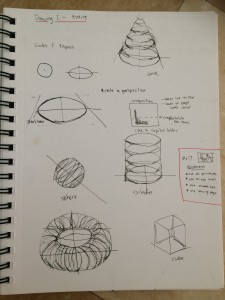 I am so very tired of drawing cubes. I don’t think I can articulate how fed up I am with cubes. I’ve drawn more cubes in the last six weeks than in my entire life. I know how important it is to have a solid understanding of the primitives, but wow I am tired of cubes. Thankfully, we have just progressed past cubes in Drawing I. You can see from my notes that we’ve taken on spheres, cones, cylinders, and the elusive torus.
I am so very tired of drawing cubes. I don’t think I can articulate how fed up I am with cubes. I’ve drawn more cubes in the last six weeks than in my entire life. I know how important it is to have a solid understanding of the primitives, but wow I am tired of cubes. Thankfully, we have just progressed past cubes in Drawing I. You can see from my notes that we’ve taken on spheres, cones, cylinders, and the elusive torus.
Our first assignment incorporating all of these shapes is a 14×17 inch drawing. We are required to use at least of of each primitive. They are all required to be transparent. At least one form has to be outside the sheet boundary, one must be below the horizon, one above, and one spanning the horizon line. We were told that the most important part of this assignment is the composition we chose.
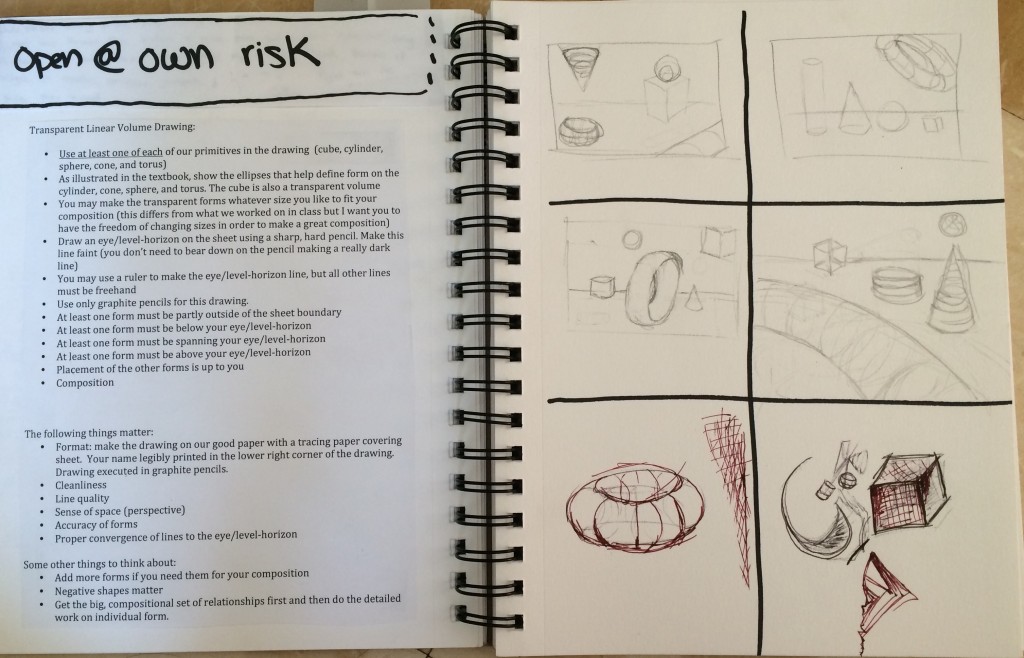
I started by drawing thumbnails of a few possible compositions. After settling on one composition, I took sketch paper and drew out the shapes in sharpie, just to make sure that I liked the composition. Seeing it on a larger scale, I was sure that I met all of the requirements of the assignment and that the composition was “happy,” as Michael Massey puts it.
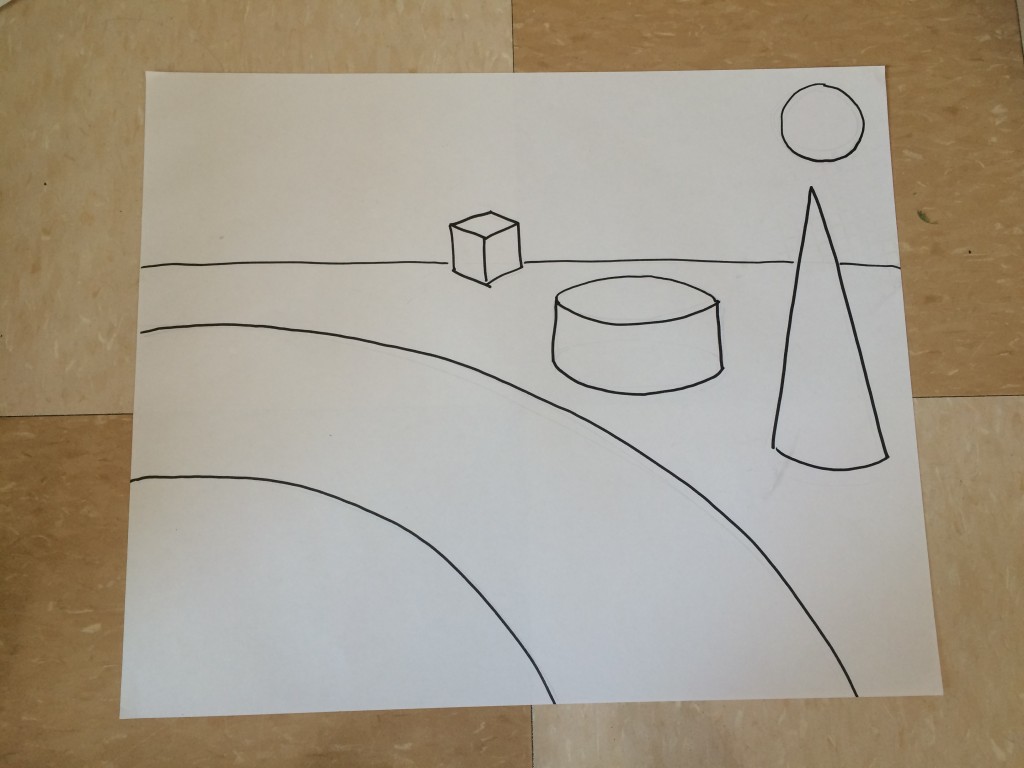
I’m now in the process of completing this project. Over the next couple days, I’ll carefully draw the details of each shape, like I’ve already done for the cone. Before turning in the piece, I’ll sign and date it and cover it with tracing paper, as per my professor’s specifications.
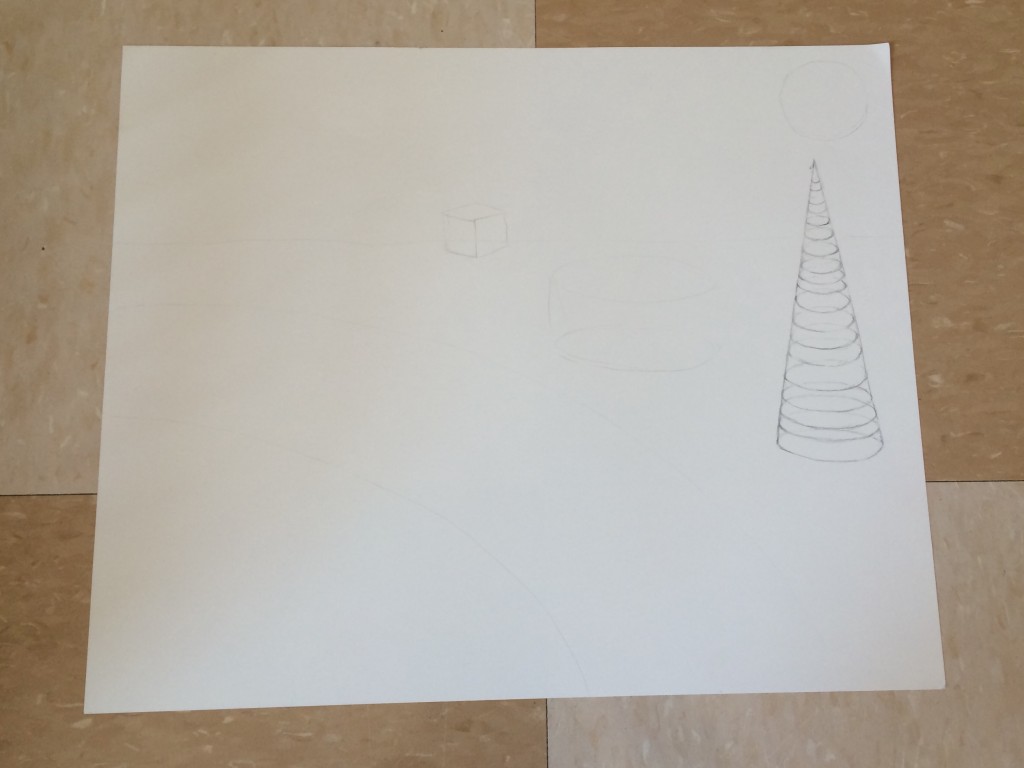
What is the strongest aspect of this work?
I think that the composition of this work is very strong. I really like how I chose to place the primitives. They lend to a sense of continuity moving from the bottom left to the top right.
What is the weakest aspect?
I think the weakest aspect of this piece is going to be keeping the primitives true in form. I’m not very good yet at showing the ellipses on these primitives to give them form.
How can the composition or form be improved?
I would love to add color, but sadly, that’s not up to me. I really like using color as a compositional element. However, I think it’s really good practice to have to do it with just line, as difficult as it is proving.
How can the project be strengthened conceptually?
There isn’t much to this piece conceptually. The requirements of the assignment were pretty straightforward and didn’t really leave much room for individual concepts or branching out.
How can the project be strengthened technically?
I think that the technical strengths, especially in a piece that is so intensely technical can only come with practice. It’s definitely difficult to draw primitives accurately and I’m aware that there are a lot of small inaccuracies in my piece.
Responses to Upperclassmen’s Presentations
Rachel Broussard
I really enjoyed Rachel’s advice for art students. As cliche as this is, hearing it all from someone who’s made it to their senior year of the program is really encouraging. Sitting in Drawing I, sketching out what seems like the 500th cube, the prospect of studying art for four years can seem daunting. Rachel gave me tools – taking advantage of the art around me, setting up studio space, and making time for my art – that will help me make my education in art extremely engaging and successful.
Caelan Navarrete
Caelan made me realize the importance of making outside work. I think I’ve gotten really caught up with making deadlines and driving myself crazy to try and complete projects to my professors liking. I need to make an effort to put time aside to do what I love – make art. Another thing Caelan emphasized was the importance of an internship. I’m really excited to learn by doing and really get my hands dirty in the real world of design.
Shelby Savage
I was really interested in the places that Shelby drew her inspiration from. She put an emphasis on using the past as a pushing off point. I really like the idea that the conversation around any topic is just that – a conversation. In order to form an opinion, or a piece of art, we have to see what other voices, or artists, have said about the subject. Another striking aspect of Shelby’s presentation was how pretty it was. While all the upperclassmen’s work and message was beautiful, I was most impressed by the way that Shelby presented her work. I could see the intentional choices behind the design of her slides. I really liked that.
Paul Young
Paul’s work was really interesting to me because I could see its real life application. I really enjoyed seeing the work that he has been commissioned to do for music events. Thinking about how design work is applied in the real world is really interesting. The impression that I was left with from Paul’s presentation was the need to make time, make work, and make connections.
Crissy Smith
Crissy emphasized the importance of knowing how to present yourself as an artist. This makes me think a lot about the conversation we had about the relationship between artist and entrepreneur. It’s so important to know how to talk about your work and to have a portfolio that presents you and your work accurately. If you can’t talk for your work, it won’t matter that your work speaks for itself.
Juliana Ramirez
I learned a lot from Juliana’s presentation. I really appreciated her emphasis on keeping a sketchbook. I like the idea that a sketchbook is full of lists and ideas that can be used later on when you have the dreaded “artist’s block.” I think I need to revise the way I use my sketchbook. Often, I focus too much on making each drawing look like professional work, but a sketchbook should be a more natural flow of ideas and concepts.
Design Smart Websites
*click on images for analysis*
-

-
http://scitech.urjcamps.org
-

-
https://www.pinterest.com
-

-
https://stedwards.app.box.com/files
-

-
http://apple.com
The Line Between Abstraction and Figuration
I had a little trouble beginning this assignment. I visited the sites that were recommended and I even put “contemporary artists” in the search bar of google, but I couldn’t find an artist that I felt compelled to write about. I was annoyed and feeling a little stuck, because I have my first real college paper due on Monday and art homework is generally more fun. And so, I did what so many college students do to procrastinate and I turned to social media. I wasn’t very far down my dashboard on Tumblr when I came across a post that caught my eye. I’d found my contemporary artist.
Sandy Dooley’s work originally caught my eye because of the vibrant colors she uses. I looked closer and was amazed to find a landscape scene being formed by all of that color. I was reminded of artists like Van Gogh and Monet, who take what they see and make it a world of color. I clicked the hyperlink attached to her name in the post (thank goodness the original poster knew a thing or two about crediting artists) and was taken to an interview where Dooley discusses her work with Saatchi Art, an online art carrier. I read through the Q and A and fell in love with her description of “exploring the line between abstraction and figuration.” She put words to what I had noticed initially, the emergence of a landscape scene from a sea of color.
I found Dooley’s blog and read more about her life and what brought her to make art like this. Dooley went to St Martin’s School of Art in Central London. I was very interested to find that she is based in the United Kingdom. When I think of landscapes in the UK, dull colors and dreary rain are what come to mind. I hadn’t pictured vibrant colors like the ones that Dooley uses in her paintings.
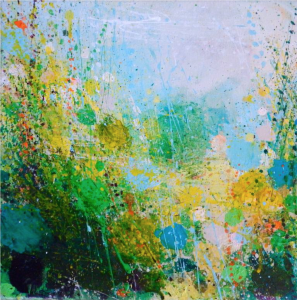
Sunshine Summer
Sandy Dooley
United Kingdom
Painting
Size: 11.8 H x 11.8 W x 1.3 in
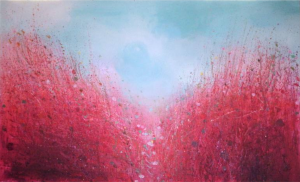
Red Path
Sandy Dooley
United Kingdom
Painting
Size: 43.3 H x 70.9 W x 1.3 in
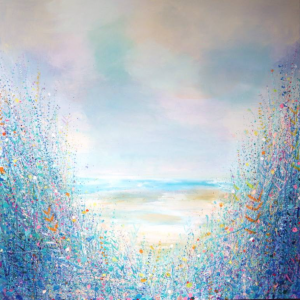
Beach
Sandy Dooley
United Kingdom
Painting
Size: 43.3 H x 43.3 W x 1.3 in

Winter Beach
Sandy Dooley
United Kingdom
Painting
Size: 11.8 H x 35.4 W x 1.3 in

















